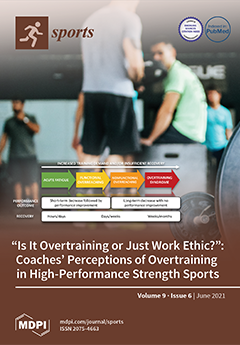Laboratory assessments of maximal oxygen uptake (VO
2max) are considered the “gold standard” for ascertaining cardiovascular fitness, but they are not always practical for use in team sport settings. Therefore, the purpose of the current study was to compare the criterion assessment
[...] Read more.
Laboratory assessments of maximal oxygen uptake (VO
2max) are considered the “gold standard” for ascertaining cardiovascular fitness, but they are not always practical for use in team sport settings. Therefore, the purpose of the current study was to compare the criterion assessment of VO
2max on a treadmill to the progressive, multistage 20-m shuttle run test (i.e., Beep test), and to determine the predictability of 6 previously established Beep test predictive equations (i.e., Chatterjee, Flouris, Leger, Leger and Gadoury, Ramsbottom, St. Clair-Gibson). Collegiate women field hockey athletes (n = 65, mean±SD: age 19.6 ± 1.2 years; weight 64.7 ± 6.1 kg) completed criterion VO
2max (mean ± SD: 46.4 ± 4.6 mL
·kg
−1·min
−1) and Beep tests to volitional fatigue. According to Bland–Altman and Ordinary Least Products Regressions, the Ramsbottom (46.5 ± 4.2 mL
·kg
−1·min
−1) and Flouris (46.3 ± 3.8 mL
·kg
−1·min
−1) equations were considered valid predictions of criterion measured VO
2max (46.4 ± 4.6). The Chatterjee, Leger, Leger and Gadoury, and St. Clair-Gibson equations overestimated VO
2max, and are not recommended for use with women collegiate field hockey athletes. The Ramsbottom and Flouris estimates of VO
2max from 20-m shuttle performances may be used in this population. For accurate estimates of VO
2max, the clientele’s age, fitness level, and training history should be considered when selecting equations.
Full article






